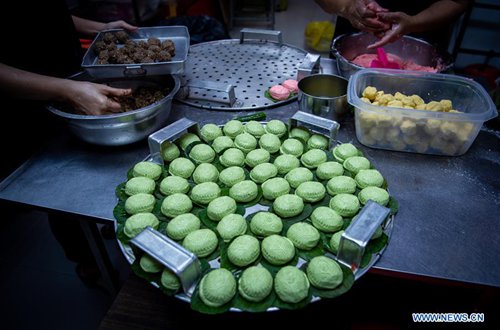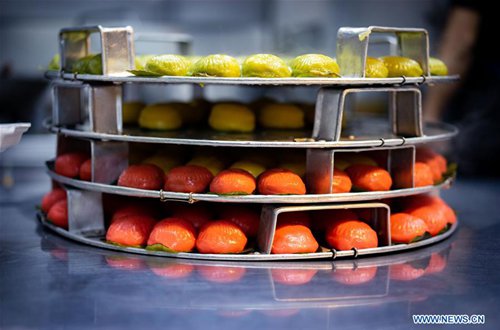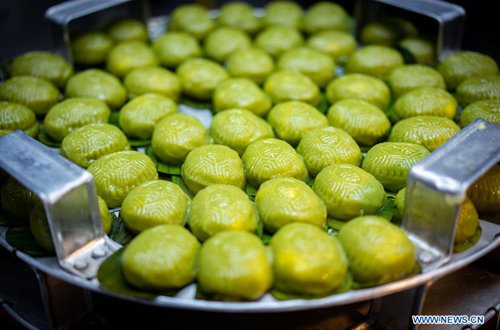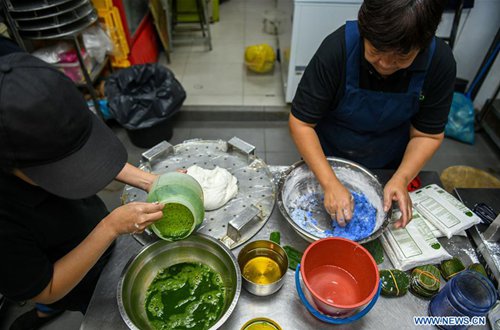Malaysians make Nyonya Kuih rice cakes in Kuala Lumpur

Karen Tee Kwee Ling (L) and her mother Linda Yau Sew Luan make Nyonya Kuih rice cakes at RizCoconut, a restaurant she runs, in Kuala Lumpur, Malaysia, Sept. 1, 2019. The Nyonya Kuih is a Malaysian steamed rice cake with a Chinese descent. Its typical ingredients include rice or glutinous rice, spices, coconut juice and plant-based pigment. In most cases the Nyonya Kuih is still made by hand, a technique adopted by the local Malaysian-Chinese community for generations. (Photo: Xinhua)

Karen Tee Kwee Ling (1st R) makes Nyonya Kuih rice cakes at RizCoconut, a restaurant she runs, in Kuala Lumpur, Malaysia, Sept. 1, 2019. The Nyonya Kuih is a Malaysian steamed rice cake with a Chinese descent. Its typical ingredients include rice or glutinous rice, spices, coconut juice and plant-based pigment. In most cases the Nyonya Kuih is still made by hand, a technique adopted by the local Malaysian-Chinese community for generations.(Photo: Xinhua)

Karen Tee Kwee Ling (R) and her mother Linda Yau Sew Luan arrange Nyonya Kuih rice cakes on plates at RizCoconut, a restaurant she runs, in Kuala Lumpur, Malaysia, Sept. 1, 2019. The Nyonya Kuih is a Malaysian steamed rice cake with a Chinese descent. Its typical ingredients include rice or glutinous rice, spices, coconut juice and plant-based pigment. In most cases the Nyonya Kuih is still made by hand, a technique adopted by the local Malaysian-Chinese community for generations. (Photo: Xinhua)

Photo taken on Sept. 1, 2019 shows an assortment of Nyonya Kuih rice cakes in Kuala Lumpur, Malaysia. The Nyonya Kuih is a Malaysian steamed rice cake with a Chinese descent. Its typical ingredients include rice or glutinous rice, spices, coconut juice and plant-based pigment. In most cases the Nyonya Kuih is still made by hand, a technique adopted by the local Malaysian-Chinese community for generations. (Photo: Chong Voon Chung/Xinhua)

Photo taken on Sept. 1, 2019 shows Nyonya Kuih rice cakes in Kuala Lumpur, Malaysia. The Nyonya Kuih is a Malaysian steamed rice cake with a Chinese descent. Its typical ingredients include rice or glutinous rice, spices, coconut juice and plant-based pigment. In most cases the Nyonya Kuih is still made by hand, a technique adopted by the local Malaysian-Chinese community for generations. (Photo: Xinhua)

Photo taken on Sept. 1, 2019 shows Nyonya Kuih rice cakes in Kuala Lumpur, Malaysia. The Nyonya Kuih is a Malaysian steamed rice cake with a Chinese descent. Its typical ingredients include rice or glutinous rice, spices, coconut juice and plant-based pigment. In most cases the Nyonya Kuih is still made by hand, a technique adopted by the local Malaysian-Chinese community for generations.(Photo: Xinhua)

A staff member of the restaurant RizCoconut removes the cover of a steamer in which an assortment of Nyonya Kuih rice cakes are cooked in Kuala Lumpur, Malaysia, Sept. 1, 2019. The Nyonya Kuih is a Malaysian steamed rice cake with a Chinese descent. Its typical ingredients include rice or glutinous rice, spices, coconut juice and plant-based pigment. In most cases the Nyonya Kuih is still made by hand, a technique adopted by the local Malaysian-Chinese community for generations. (Photo: Xinhua)

A staff member of the restaurant RizCoconut removes an assortment of Nyonya Kuih rice cakes from a steamer in Kuala Lumpur, Malaysia, Sept. 1, 2019. The Nyonya Kuih is a Malaysian steamed rice cake with a Chinese descent. Its typical ingredients include rice or glutinous rice, spices, coconut juice and plant-based pigment. In most cases the Nyonya Kuih is still made by hand, a technique adopted by the local Malaysian-Chinese community for generations. (Photo: Chong Voon Chung/Xinhua)

Karen Tee Kwee Ling displays an assortment of Nyonya Kuih rice cakes at RizCoconut, a restaurant she runs, in Kuala Lumpur, Malaysia, Sept. 1, 2019. The Nyonya Kuih is a Malaysian steamed rice cake with a Chinese descent. Its typical ingredients include rice or glutinous rice, spices, coconut juice and plant-based pigment. In most cases the Nyonya Kuih is still made by hand, a technique adopted by the local Malaysian-Chinese community for generations. (Photo: Chong Voon Chung/Xinhua)

Karen Tee Kwee Ling (L) and her mother Linda Yau Sew Luan make Nyonya Kuih rice cakes at RizCoconut, a restaurant she runs, in Kuala Lumpur, Malaysia, Sept. 1, 2019. The Nyonya Kuih is a Malaysian steamed rice cake with a Chinese descent. Its typical ingredients include rice or glutinous rice, spices, coconut juice and plant-based pigment. In most cases the Nyonya Kuih is still made by hand, a technique adopted by the local Malaysian-Chinese community for generations. (Photo: Chong Voon Chung/Xinhua)

Linda Yau Sew Luan (R) makes Nyonya Kuih rice cakes at RizCoconut, a restaurant run by her daughter Karen Tee Kwee Ling, in Kuala Lumpur, Malaysia, Sept. 1, 2019. The Nyonya Kuih is a Malaysian steamed rice cake with a Chinese descent. Its typical ingredients include rice or glutinous rice, spices, coconut juice and plant-based pigment. In most cases the Nyonya Kuih is still made by hand, a technique adopted by the local Malaysian-Chinese community for generations. (Photo: Chong Voon Chung/Xinhua)

Karen Tee Kwee Ling makes Nyonya Kuih rice cakes at RizCoconut, a restaurant she runs, in Kuala Lumpur, Malaysia, Sept. 1, 2019. The Nyonya Kuih is a Malaysian steamed rice cake with a Chinese descent. Its typical ingredients include rice or glutinous rice, spices, coconut juice and plant-based pigment. In most cases the Nyonya Kuih is still made by hand, a technique adopted by the local Malaysian-Chinese community for generations. (Photo: Chong Voon Chung/Xinhua)

Photo taken on Sept. 1, 2019 shows Nyonya Kuih rice cakes in Kuala Lumpur, Malaysia. The Nyonya Kuih is a Malaysian steamed rice cake with a Chinese descent. Its typical ingredients include rice or glutinous rice, spices, coconut juice and plant-based pigment. In most cases the Nyonya Kuih is still made by hand, a technique adopted by the local Malaysian-Chinese community for generations. (Photo: Chong Voon Chung/Xinhua)

Linda Yau Sew Luan makes Nyonya Kuih rice cakes at RizCoconut, a restaurant run by her daughter Karen Tee Kwee Ling, in Kuala Lumpur, Malaysia, Sept. 1, 2019. The Nyonya Kuih is a Malaysian steamed rice cake with a Chinese descent. Its typical ingredients include rice or glutinous rice, spices, coconut juice and plant-based pigment. In most cases the Nyonya Kuih is still made by hand, a technique adopted by the local Malaysian-Chinese community for generations. (Photo: Chong Voon Chung/Xinhua)

Karen Tee Kwee Ling arranges Nyonya Kuih rice cakes on plates at RizCoconut, a restaurant she runs, in Kuala Lumpur, Malaysia, Sept. 1, 2019. The Nyonya Kuih is a Malaysian steamed rice cake with a Chinese descent. Its typical ingredients include rice or glutinous rice, spices, coconut juice and plant-based pigment. In most cases the Nyonya Kuih is still made by hand, a technique adopted by the local Malaysian-Chinese community for generations. (Photo: Chong Voon Chung/Xinhua)

Linda Yau Sew Luan makes Nyonya Kuih rice cakes at RizCoconut, a restaurant run by her daughter Karen Tee Kwee Ling, in Kuala Lumpur, Malaysia, Sept. 1, 2019. The Nyonya Kuih is a Malaysian steamed rice cake with a Chinese descent. Its typical ingredients include rice or glutinous rice, spices, coconut juice and plant-based pigment. In most cases the Nyonya Kuih is still made by hand, a technique adopted by the local Malaysian-Chinese community for generations. (Photo: Chong Voon Chung/Xinhua)

A staff member of the restaurant RizCoconut puts an assortment of Nyonya Kuih rice cakes into a steamer in Kuala Lumpur, Malaysia, Sept. 1, 2019. The Nyonya Kuih is a Malaysian steamed rice cake with a Chinese descent. Its typical ingredients include rice or glutinous rice, spices, coconut juice and plant-based pigment. In most cases the Nyonya Kuih is still made by hand, a technique adopted by the local Malaysian-Chinese community for generations. (Photo: Chong Voon Chung/Xinhua)